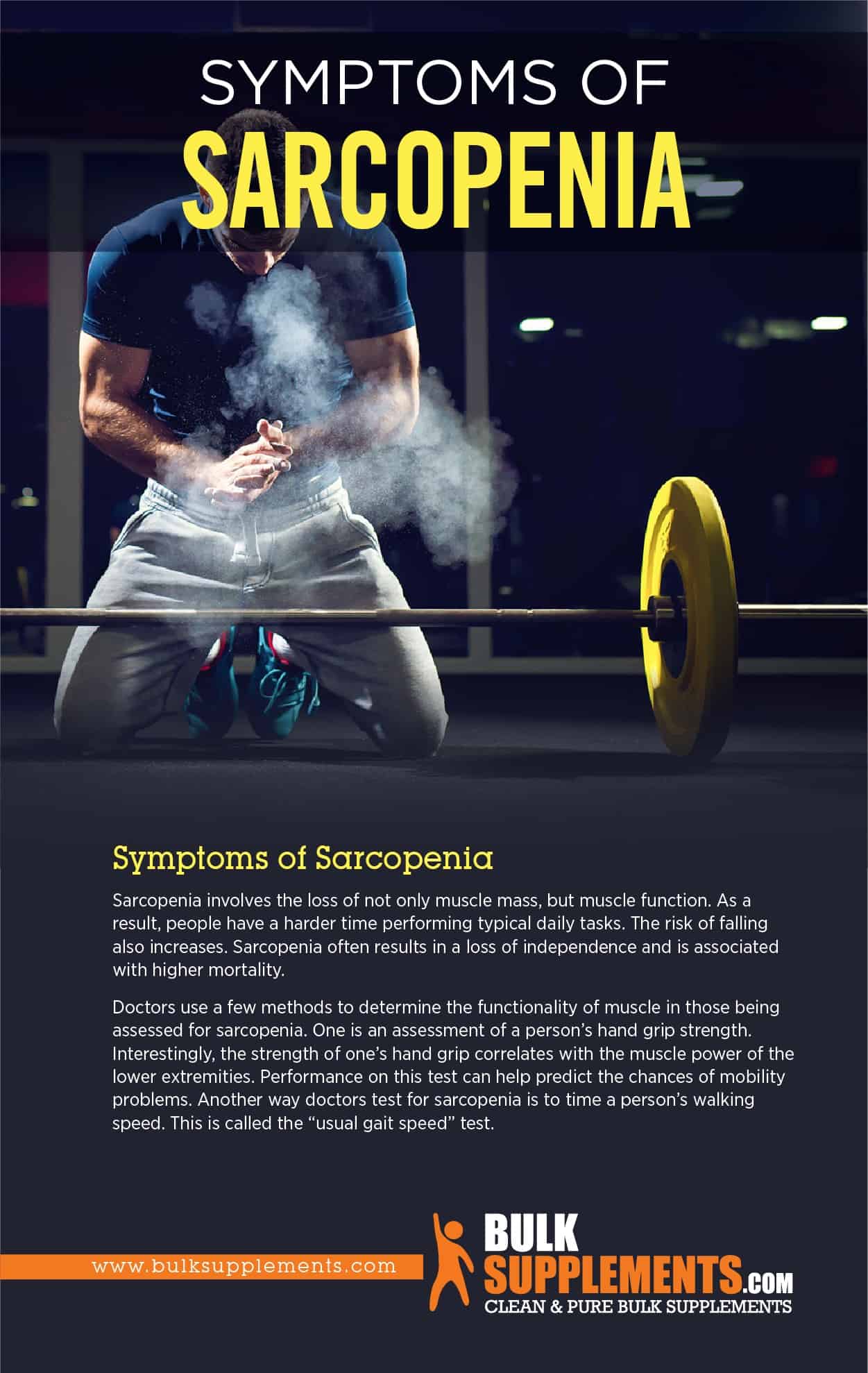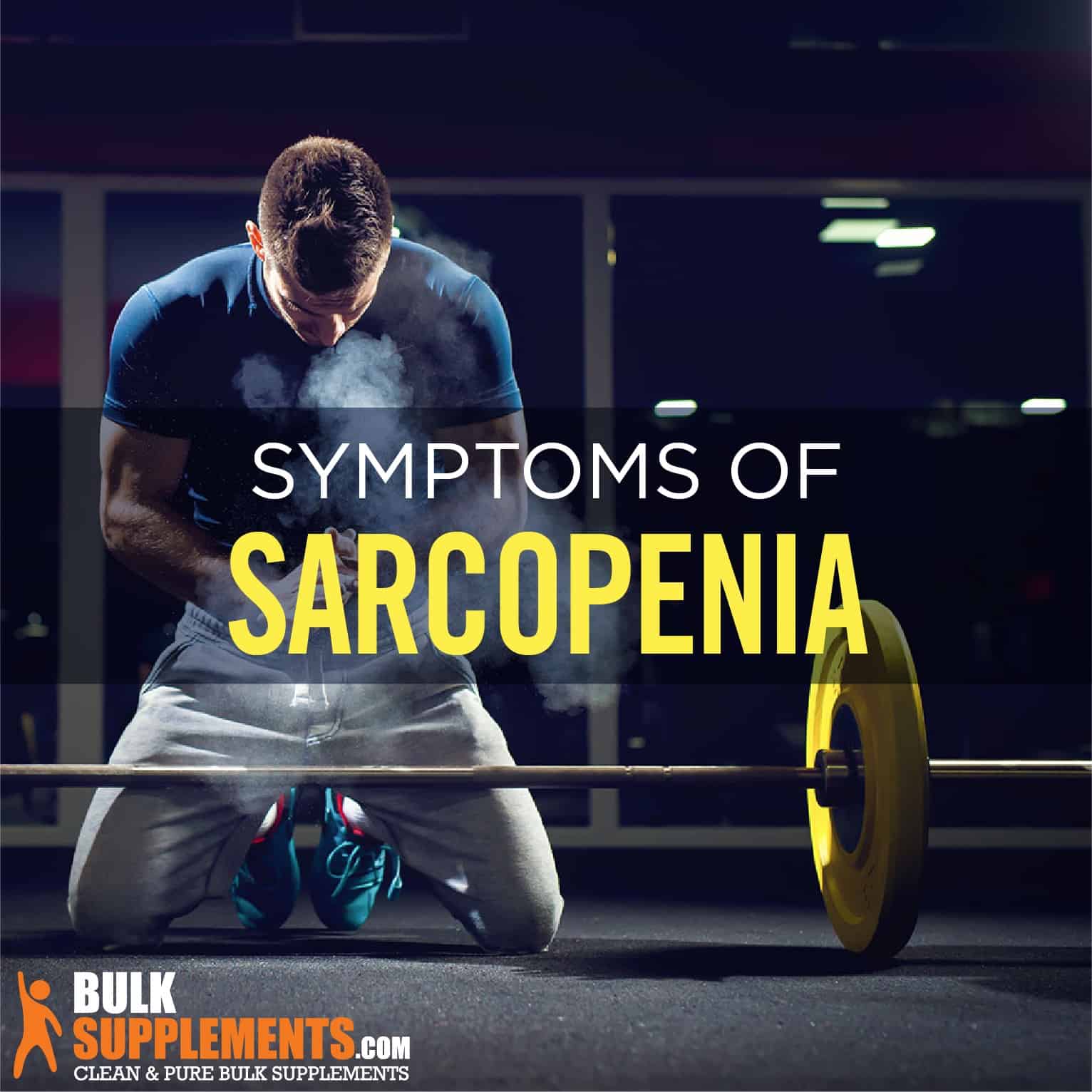What is Sarcopenia?
Sarcopenia is a syndrome that describes the age-related reduction in the mass and strength of a person’s skeletal muscles. As a result of the normal changes in hormones, muscle metabolism and lifestyle that occur as someone gets older, some loss of muscle is expected. In some cases, however, factors other than aging cause it to progress faster. As a result, even younger adults can experience a problematic loss in muscle mass and strength.
Sarcopenia can be mild, moderate or severe. The diagnostic criteria differ within the medical community. By some estimates, 5-13 percent of people ages 60-70 have the condition. That number jumps to 11-50 percent of those over the age of 80. The prevalence of sarcopenia is expected to increase over the next few decades (x).
Despite how common and, to some extent, how normal sarcopenia is within the older adult population, it warrants attention because it contributes to disability, poor quality of life and even death, especially in women (x).
Certain factors such as sedentary lifestyle, poor nutrition and chronic disease contribute to the onset of sarcopenia. While there is no direct cure for it, there are ways to manage and even prevent it in the first place. Remaining physically active throughout all stages of life is the simplest of them.
Causes of Sarcopenia
Two kinds of sarcopenia have been identified (x).
- Primary sarcopenia – changes in muscle caused by the effects of aging only
- Secondary sarcopenia – changes in muscle that stem from one or more other factors like the presence of another disease
The following are causes that often lead to sarcopenia:
Reduced Physical Activity
Older adults engage in the least amount of physical activity and exercise of any population (x). As a result, muscles naturally atrophy. Compounding this problem is the fact that as people age, building muscle becomes more difficult (x).
Muscle mass decreases, but more importantly, the muscle becomes much weaker. In a study of 1,880 elderly men and women, muscle strength declined much faster than actual muscle mass. Furthermore, gains in muscle mass did not necessarily translate to greater strength (x).
Younger people can also have sedentary lifestyles that lead to sarcopenia. This is most commonly due to another underlying illness, however.
Poor Nutrition
Older adults are at an increased risk of nutritional deficiencies. There are many reasons for this. One is that as lean body mass decreases, so does the need for overall calories. On the other hand, there may be a greater demand for other nutrients as a result of changing conditions within the body. Factors such as food affordability and the ability to obtain and prepare food also limits some people’s access to proper nutrition (x).
Studies show that protein intake in particular might predict someone’s risk of developing sarcopenia. Protein and amino acids stimulate muscle growth. The RDA for protein for adults is 0.8 grams per kilograms of bodyweight (x). That amount is likely not enough to prevent sarcopenia in older adults, however. Multiple studies showed that men and women who consumed 0.8 g/kg or less per day lost lean mass faster than those who consumed 1.2 g/kg or more (x).
Hormone Levels
Several hormones play a role in maintaining the strength and integrity of skeletal muscle. As people age, levels rise or decline causing muscle breakdown. Hormones that influence muscle quality include (x):
- Growth hormone
- Ghrelin
- Male hormones
- Insulin
- Oxytocin
- Vitamin D
- Cortisol
Inflammatory Disorders
People with sarcopenia usually have higher levels of inflammatory compounds in their blood. Regardless of age, having any type of inflammatory disorder may increase risk of sarcopenia. Examples of these include rheumatoid arthritis, Crohn’s disease, type 2 diabetes and cardiovascular disease (x, x).
Other Diseases
Cancer, thyroid dysfunction, advanced organ failure and neurodegenerative diseases can cause muscle to break down in people of all ages (x).
Obesity
The combination of obesity and sarcopenia, called sarcopenic obesity, is a growing public health threat that involves the influence of hormones, diet and inflammation (x). When people are young, insulin acts as an anabolic hormone that helps build muscle. However, when glucose metabolism goes awry, as is often the case with obesity, this is no longer the case. Instead, the composition of skeletal muscle changes and can become marbled with fat. A decrease in skeletal muscle impacts metabolism, which further perpetuates the sarcopenia-obesity cycle (x).
Symptoms of Sarcopenia
Sarcopenia involves the loss of not only muscle mass, but muscle function. As a result, people have a harder time performing typical daily tasks. The risk of falling also increases. Sarcopenia often results in a loss of independence and is associated with higher mortality (x).
Doctors use a few methods to determine the functionality of muscle in those being assessed for sarcopenia. One is an assessment of a person’s hand grip strength. Interestingly, the strength of one’s hand grip correlates with the muscle power of the lower extremities. Performance on this test can help predict the chances of mobility problems. Another way doctors test for sarcopenia is to time a person’s walking speed. This is called the “usual gait speed” test (x).

Treatments for Sarcopenia
Exercise and Nutrition
Exercise is a standard treatment for sarcopenia. Not only does strength training help rebuild muscle, but exercise can also minimize the effects of chronic diseases that can contribute to sarcopenia in the first place (x).
Adding protein to the diet improves the effects of exercise. People who exercise and increase their protein intake typically experience better results than those who just exercise alone (x).
Though exercise is considered an important part of sarcopenia management, there currently is no standard recommendation of which types of exercise are most appropriate and for whom. Additionally, studies conflict on the extent to which it actually improves the condition (x).
Hormone Replacement Therapy
Research shows that some people find success with managing sarcopenia by replacing some of the hormones that decline with age. For example, men between the ages of 65 and 80 who received a combination of growth hormone and male hormones showed improvements in lower body strength (x). However, more studies are necessary to determine the safety and effectiveness of hormone replacement therapy (x).
Supplements for Sarcopenia
Essential Amino Acids
Essential amino acids (EAA) are amino acids that are essential for bodily function, but must be acquired through the diet. Amino acids are carbon-containing molecules that are the building blocks of protein. They form chains that become protein molecules. Proteins provide structure to all cells — especially muscle — and play a role in growth, repairing tissue and building muscle (x). Studies show that EAAs help build muscle and strength in people with sarcopenia (x).
As a dietary supplement, take 15 g of essential amino acid (EAA) powder daily, or as directed by a physician. Individual needs may vary. For best results, use prior to workouts.
Whey Protein
Whey protein isolate is used by those trying to lose weight or build muscle. This form is used in many meal replacement programs because of its high protein content, which curbs the appetite and aids in quicker weight loss (x). Studies show that whey protein combined with exercise helps build muscle in cases of sarcopenia (x). The generally recommended serving size of whey protein powder isolate is 15 to 30 grams daily. However, the dosage can vary depending on the person’s build and body weight, rate of metabolism and size.
Vitamin D3
Vitamin D3 is associated with muscle strength, but levels decline with age, contributing to the onset of sarcopenia. Research shows that supplementation with vitamin D3 helps improve strength and balance in the elderly (x). Supplements should be taken with care, however, since it is possible to take too much. As a dietary supplement, take 50 mg of vitamin D3 cholecalciferol powder daily or as recommended by your doctor.
Because of how concentrated this supplement is, it should be measured and consumed carefully. Do not supplement this product if you do not possess an accurate milligram scale. It is strongly suggested that those unsure of serving sizes choose less concentrated forms of vitamin D3 to avoid overdose. Since individual needs may vary, always start on the lower end of dosing.
Omega-3 Fatty Acids
Recently, studies indicate that omega-3 fatty acids may enhance the therapeutic effects of protein and exercise in those with sarcopenia (x). This polyunsaturated fatty acid can be found in a variety of supplemental forms.
Pure fish oil softgels contain 1,000 mg of omega-3 fatty acids. The suggested dosage is two capsules, two to three times a day. Side effects resulting from overuse include diarrhea, acid reflux and general stomach upset. Anyone allergic to fish or taking blood thinners should avoid this product or talk to a doctor before use.
Pure krill oil softgels are another source of omega-3 fatty acids, providing 500 mg per serving. As a supplement, take 2 soft gels once or twice a day. Do not use this supplement if you suffer from shellfish allergies. Women who are pregnant or nursing should contact a doctor before using. If the product causes stomach upset, take with food.
The Bottom Line
Sarcopenia is a disease of the skeletal muscle. It’s a condition associated with advanced age, but can occur in people who are younger. Muscle mass and strength decrease, which leads to an inability to perform tasks of daily life. In addition, the risk of falling and bone fractures increases. Sarcopenia takes a big toll on society as well as the people who have to manage it everyday. Maintaining muscle mass and avoiding malnutrition throughout all stages of life appears to be the best way to prevent and ultimately treat sarcopenia. Exercise, a protein-rich diet and supplements can all help people maintain as much muscle strength as possible.


